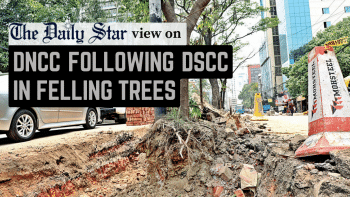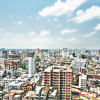Trees are Dhaka’s saviours

Rising temperature is now perceived as an existential threat to humans. In recent years, heatwaves in European countries such as Greece, Italy, Spain, France, and the UK have resulted in numerous deaths and wildfires. In Bangladesh, we experienced extreme heat last year, leading the government to shut down primary schools as temperatures surged over 40°C in June. According to the Bangladesh Meteorological Department, the temperature broke a 58-year record in Dhaka city.
With heatwaves becoming more frequent and prolonged, there will be more severe impacts in cities like Dhaka where buildings are densely packed together and the number of trees and amount of greenery are dwindling.
Although the rising temperature has a global effect on liveability and poses threats to species worldwide, the impact of temperature increase in urban areas is likely to be magnified multiple times compared to other areas, due to the Urban Heat Island (UHI) effect—a phenomenon characterised by higher temperatures in cities compared to surrounding rural areas.
According to an article published in Theoretical and Applied Climatology, temperatures in some areas of Dhaka are 3°C higher than in its boundary areas, and the warmest and coldest temperatures in Dhaka city are approximately 7°C and 5°C higher than outside the city. This temperature difference is mainly attributed to the higher number of heat-absorbing surfaces, less tree coverage in the city, and anthropogenic waste heat (from industry, cars, cooling systems, and others).
Increasing tree canopies have been used the world over as a crucial tool to control urban heat by leveraging the natural characteristics of trees. Trees can help regulate temperature in two main ways: 1) by providing shade, which blocks direct sunlight from reaching the surface; and 2) through evapotranspiration, which acts as a cooling process. Therefore, maintaining a liveable and comfortable temperature in cities by increasing tree canopies and protecting existing ones should be a key concern for urban planners and policymakers
In efforts to protect and monitor trees, there is a need for a proper database of tree canopies.
Recently, the Geographic Research Unit of Bengal Institute undertook a pioneering initiative to map the tree canopies in Dhaka city, preparing a comprehensive and detailed database for all the tree canopies in the city. According to this study, the total canopy cover of Dhaka city is 4,169 hectares, accounting for 13.71 percent of the total area of the city. Tree canopy coverage is higher in areas under Dhaka North City Corporation, approximately 15.39 percent, while only 10.31 percent of trees are present in Dhaka South City Corporation areas.
Experts suggest that a minimum of 25 percent tree coverage is needed for a city to be considered liveable. Nearby mega-cities present disappointing figures as well. Kolkata has lost 30 percent of its tree coverage in just 10 years, leaving only 1.8 percent of tree coverage in 2021, as reported by The Times of India. For Bangkok, the percentage is nearly 5.2 percent, according to Global Forest Watch. If we look at European cities, those well-known for liveability have higher percentages of trees. For example, Oslo has 72 percent, Bern has 53 percent, Berlin has 44 percent, and Madrid, Brussels, and Vienna have 39 percent, 37 percent, and 34 percent, respectively, of tree coverage. Trees claim to have overwhelmingly positive effects on human health in these cities, where programmes to increase greenery, as well as efforts to maintain it, are operational.
Despite their significant environmental benefits, trees are facing the harshest blow in Dhaka city. With the increasing number of heat-absorbing surfaces (buildings, pavements, roads, and impervious surfaces), greenery is decreasing. Trees are being felled mercilessly to accommodate development activities in Dhaka and, on many occasions, for the commercial benefits of a few. In recent times, this cruelty towards trees has been evident on Satmasjid Road in the capital's Dhanmondi area, where hundreds of trees were reportedly felled for road divider renovation.
In May 2021, a similar incident occurred in the historic Suhrawardy Uddyan, where hundreds of old trees were cut down to make way for seven restaurants, a flower market, toilet facilities, and a children's park—all in the name of development and public service. While many believe that the design could have been altered to preserve trees in the area, commercial profits took precedence over the environment. This incident was protested by numerous environmental activist groups, and a writ petition was filed to halt the tree felling. However, reportedly there was a brazen flouting of the high court order, and the continued felling of trees persisted.
In some instances, deforestation is happening on a much bigger scale. According to the Bangladesh Environment Lawyers' Association (Bela), 1,100,000 trees have been cut to facilitate 2,000 plots at Purbachal, meaning an average of 550 trees of different sizes were felled to prepare a single plot. The majority of the trees cut were sal trees, and despite the requirement for special permission to cut sal trees, none was obtained during the tree felling for the plots.
The scenario does not look good for trees and the livability of Dhaka city, as deforestation is an ongoing process happening openly during daylight. The lack of initiative to protect greenery, coupled with negligence from the respective authorities, is likely to exacerbate the condition of greenery in Dhaka City. Things seem dire as people brace for the imminent fight against heat waves and air pollution. Infrastructure development at the cost of trees will not be sustainable and healthy. Among numerous problems in Dhaka city, trees could provide us with breathing space in this concrete forest, acting as lights at the end of the tunnel. The question now is: are we willing enough to reach that end, or will we simply lay back and witness the destruction of the trees, and turn this city into a hostile place to live?
Bandhan Dhar and Sanjoy Roy are research and design associate and coordinator of the Geographic Research Unit (GRU) respectively, at the Bengal Institute for Architecture, Landscapes, and Settlements in Dhaka, Bangladesh.
Views expressed in this article are the author's own.
Follow The Daily Star Opinion on Facebook for the latest opinions, commentaries and analyses by experts and professionals. To contribute your article or letter to The Daily Star Opinion, see our guidelines for submission.

 For all latest news, follow The Daily Star's Google News channel.
For all latest news, follow The Daily Star's Google News channel. 












Comments